Ski report from Kungsleden, March-April 1997
Also available translated to German.
If you want the background to these stories, see the introduction.
Photographs are included in this text, but if you prefer you
can look at the photos separately in the gallery.
This Kungsleden trip became rather long and tedious for various reasons,
and although it lasted five weeks, a lot of time was spent waiting out storms
or retracing my steps. Perhaps there's something to be learned from this anyway.
But if you'd rather just read about certain sections, try the following :
March 6th. This was to be my second ski tour, following the success of my
tentative trip in Tarredalen a year before. Now I felt ready to commit myself
to a one-way tour, Kvikkjokk to Saltoluokta, 70km and 4 days skiing, but
I was budgeting 10 days to allow for day trips, rest days and bad weather.
I moved in with my friends in Jokkmokk again, where I could train up my skiing
muscles, eat huge and wonderful lasagnes, and wait for storms to pass.
This they didn't do. Even the locals were appalled by how bad the weather was,
and it had been so for weeks. Jokkmokk was OK, except that it was +8C and
raining when it should have been -20, but 100km west in the mountains it was
blowing over 30 m/s. The good news was that there were record amounts of snow.
After 5 days I gave up waiting for a good forecast, and decided to sit it out
in Kvikkjokk instead, where I would be ready for a quick move, albeit without
the support of home-made lasagne.
So off I went to the bus station, carrying my full 20kg pack for the first
time, and almost immediately realised that my knee was a year older than the
last time I did this, and was about to become 20 years older. It was hard to
imagine that I could ski 100km like this. More immediately, I had a nasty pain
in my knee, so I went into the supermarket to buy some chocolate, and there
she was, Pernilla. It was love at first sight - small, cheap and with
artificial red colouring, but I wanted her because I knew she would follow me
wherever I went without question, and carry my pack without complaints.
She was a child's sledge, on sale for less than I'd paid for lunch. I
collected some pieces of string and electrical conduit from other shops, and
sat at the bus station performing cosmetic surgery on my new partner.
In Kvikkjokk it was around zero, clear and still. I felt cautiously
optimistic about starting my trip the next day, and recklessly optimistic when
I woke at 6 to the same conditions, but at 7 it was blowing 10 m/s and snowing. Ugh.
It wouldn't be smart to try for the 18km to Pårtestugan in this weather with
my limited expertise. I decided on a short trip in the forest just for the
experience, and to cement my relationship with Pernilla.
I took all my equipment to make it realistic. Protected by the trees the wind
was no problem, and Pernilla seemed to enjoy our white wedding. In under an
hour I'd ascended 200m over about 3km, and I really didn't want to struggle up
that hill again another day, so I started to wonder about carrying on. I knew the trail
would get more exposed later, but there would always be trees and deep snow nearby to
dig myself down in. I carried on, always prepared to turn back and pretend I'd
never had that reckless thought. After two hours the forest opened up to very
exposed lakes, and I hesitated. I had the wind behind me, which was
comfortable, but also meant that if I got into trouble, turning back might not
be an option. But I always had my spade and windsack.
A German appeared, apparently untroubled by the head-wind he was fighting,
and completely confident that I would make it to the cabin. His confidence
infected me, and I headed on. The first lake was no problem, but as I came to
the second the clouds lowered, and I experienced my first whiteout. I saw
nothing in any direction, including down. I'd been following a heavily snowed-over
scooter track, but now it was gone. I'd taken a compass bearing before it
disappeared, but it wasn't clear how long that would help me. The cabin should
be directly in front of me, but the lake had irregular boundaries, and so using
the bearing-off technique of deliberately missing the target to one side and correcting
would be difficult. And if it were 10m back into the trees I could still miss
it. Not a nice feeling. Much nicer when the clouds moved on and the cabin
popped out in front of me. An hour later the weather worsened, and I was glad
I hadn't risked taking a lunch break on the way. But I was also glad that I'd
got out of Kvikkjokk. I was on my way.
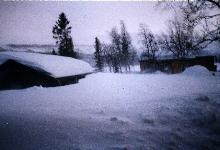 Pårte is nice, as were the wardens (and every warden I've ever met), but on
the third day of watching snow drifts form and reading "Till Fjaells"
magazines from the '70s, I was getting a little restless.
On top of the blizzards was the problem that the next stage to Aktse is around
30km long in the winter, over a regulated lake with regions of open water.
The snow was deep and untracked, and I was told that knowing when to turn
north over Tjaktjavare is crucial, and tricky in poor visibility. I wanted a
very nice day before attempting this one. It didn't come, but Germans did.
They had a tent, a GPS navigation system, and experience. No problem, whatever
the weather, we would head off together the next day. Meanwhile they kindly
shared with me something brown, tasty, and indigestible. My stomach started cramping an
hour or so later, and only relaxed slightly the following morning. But at
least I will be able to tell my grandchildren about the time I braved a
blizzard at 1, 3 and 5am to get to the outhouse, where the wind was strong
enough to blow snow up through the toilet, and to give a whole new meaning to
the term paper recycling.
Pårte is nice, as were the wardens (and every warden I've ever met), but on
the third day of watching snow drifts form and reading "Till Fjaells"
magazines from the '70s, I was getting a little restless.
On top of the blizzards was the problem that the next stage to Aktse is around
30km long in the winter, over a regulated lake with regions of open water.
The snow was deep and untracked, and I was told that knowing when to turn
north over Tjaktjavare is crucial, and tricky in poor visibility. I wanted a
very nice day before attempting this one. It didn't come, but Germans did.
They had a tent, a GPS navigation system, and experience. No problem, whatever
the weather, we would head off together the next day. Meanwhile they kindly
shared with me something brown, tasty, and indigestible. My stomach started cramping an
hour or so later, and only relaxed slightly the following morning. But at
least I will be able to tell my grandchildren about the time I braved a
blizzard at 1, 3 and 5am to get to the outhouse, where the wind was strong
enough to blow snow up through the toilet, and to give a whole new meaning to
the term paper recycling.
I didn't feel ready for my big day. But it wasn't going to happen anyway,
as the Germans had been thinking, and decided that given the record so far,
more bad weather would come, and that since they had already skied from
Hemavan, they would bow to the Gods and head back home. I contemplated the
pile of 'Till Fjaells' magazines, and realised that they were right, and that
even if I managed to get to Aktse some day soon, I would probably get stuck
there too. I reluctantly joined them back to Kvikkjokk, battling against the
wind and snow, but comforted by the 120kg of equipment that we were
collectively hauling. I was miserable - I'd been away 10 days and got to one
cabin, in horrible conditions. A feeling of profound failure hung over me.
What a difference from last year's trip. But worse was to come. As soon as we
arrived, the skies cleared, the wind disappeared, and we heard that the
forecast was for fine, stable weather. Agghhgghh ! And then we met scooters
that had come from Aktse, so there would even have been tracks to follow.
We comforted ourselves with a reindeer-heart fondue cooked on a spirit stove.
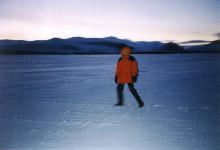 The next morning was indeed beautiful, but the temptation to head back to
Pårte was moderated by the certainty that I would be trapped there again.
Turning around a second time would be unbearable. Instead I took the bus to
Saltoluokta, thinking that I could at least see some real mountains, do some
day trips, and maybe, maybe, do my planned trip in reverse. After waiting so
long for good weather, to be watching it from bus windows for 6 hours was
agonising, but after a few hours skiing around Saltoluokta, taking a sauna,
and enjoying the beauty of the 80-year-old fjaellstation, I was happy again
and ready to start over. I at least wanted to get to Aktse and Rapadalen, even
if I decided to turn around there. I was waiting to hear about some job
interviews, but I reckoned I was safe for another 4 or 5 days.
The following morning was beautiful again, and I was happy enough to treat myself
to breakfast in the restaurant, with the justification that there is a limit
to how much home-made porridge I can stuff into myself in the morning, but no
limit to how much fresh bread and eggs I can eat, and I needed the nutrition.
My waitress was cute and somehow familiar. Yes, it was Lotta, whom I'd met on
the train up north a year before. We chatted, and it turned out that she
had the following two days off, so I abandoned my plans for Aktse, and
instead arranged that I would go off to Sitojaure, Lotta would follow the
next day, and we would ski back together.
Rapadalen may be the most beautiful place in Sweden, but I bet it can't cook.
The next morning was indeed beautiful, but the temptation to head back to
Pårte was moderated by the certainty that I would be trapped there again.
Turning around a second time would be unbearable. Instead I took the bus to
Saltoluokta, thinking that I could at least see some real mountains, do some
day trips, and maybe, maybe, do my planned trip in reverse. After waiting so
long for good weather, to be watching it from bus windows for 6 hours was
agonising, but after a few hours skiing around Saltoluokta, taking a sauna,
and enjoying the beauty of the 80-year-old fjaellstation, I was happy again
and ready to start over. I at least wanted to get to Aktse and Rapadalen, even
if I decided to turn around there. I was waiting to hear about some job
interviews, but I reckoned I was safe for another 4 or 5 days.
The following morning was beautiful again, and I was happy enough to treat myself
to breakfast in the restaurant, with the justification that there is a limit
to how much home-made porridge I can stuff into myself in the morning, but no
limit to how much fresh bread and eggs I can eat, and I needed the nutrition.
My waitress was cute and somehow familiar. Yes, it was Lotta, whom I'd met on
the train up north a year before. We chatted, and it turned out that she
had the following two days off, so I abandoned my plans for Aktse, and
instead arranged that I would go off to Sitojaure, Lotta would follow the
next day, and we would ski back together.
Rapadalen may be the most beautiful place in Sweden, but I bet it can't cook.
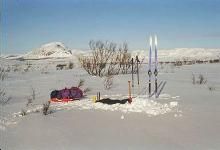 So off I went, with my stomach and heart happily filled, taking a leisurely
6 hours for the 20km of exquisite skiing to Sitojaure, stopping often for
photographs and food. It's pretty much all above tree line, flat after an
initial climb of 300m, well-marked, and just gorgeous. This is why people ski.
At the cabin were two young hunters, and a warden who loved people so much
that she should really have been in a more popular place. Her stories of whole
weeks alone there in February were heart-breaking. And she knew my friends in Jokkmokk.
So off I went, with my stomach and heart happily filled, taking a leisurely
6 hours for the 20km of exquisite skiing to Sitojaure, stopping often for
photographs and food. It's pretty much all above tree line, flat after an
initial climb of 300m, well-marked, and just gorgeous. This is why people ski.
At the cabin were two young hunters, and a warden who loved people so much
that she should really have been in a more popular place. Her stories of whole
weeks alone there in February were heart-breaking. And she knew my friends in Jokkmokk.
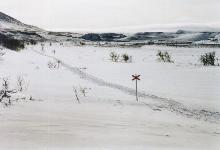 In fact everyone knows everyone up there; after a couple of weeks
you start to feel like family. That night I took a magical walk on the lake -
moonlit mountains, northern lights, and the Hale-Bop comet. Unforgetable.
I contemplated a day trip to Skierf, reputedly Sweden's most beautiful
viewpoint, but it would be over 30km, and I had to ski back to Salto the next
day, so I decided on Tjirak instead, which would be under 10km round trip, and
still 1000m high. It was clear but windy, and I got up to Tjirak in under an
hour. Too easy, I thought, and headed 200m higher to Tjiraksnjurtje.
In fact everyone knows everyone up there; after a couple of weeks
you start to feel like family. That night I took a magical walk on the lake -
moonlit mountains, northern lights, and the Hale-Bop comet. Unforgetable.
I contemplated a day trip to Skierf, reputedly Sweden's most beautiful
viewpoint, but it would be over 30km, and I had to ski back to Salto the next
day, so I decided on Tjirak instead, which would be under 10km round trip, and
still 1000m high. It was clear but windy, and I got up to Tjirak in under an
hour. Too easy, I thought, and headed 200m higher to Tjiraksnjurtje.
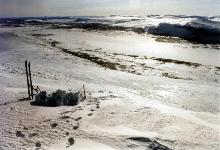 Too hard, I thought. The wind must have been over 10 m/s by then, and it was
-15C, but I had come too far to turn back, and when I finally reached the peak I
was in the coldest conditions I've ever experienced. It was one of the rare
occasions when I seriously questioned myself "what am I doing here ?".
I dug a hole and made a wall to hide behind for lunch.
When it came to taking photographs I barely
managed to run up to the peak and snap in all directions, there was no
question of giving thought to composition or exposure. By the time I got back
I'd skied over 20km, and been higher than Skierf. I knew this would happen.
I should have just gone to Skierf. Lotta arrived at the stuga just before I did,
and the warden cooked us a delicious spaghetti bolognese that slowly thawed me
out.
Too hard, I thought. The wind must have been over 10 m/s by then, and it was
-15C, but I had come too far to turn back, and when I finally reached the peak I
was in the coldest conditions I've ever experienced. It was one of the rare
occasions when I seriously questioned myself "what am I doing here ?".
I dug a hole and made a wall to hide behind for lunch.
When it came to taking photographs I barely
managed to run up to the peak and snap in all directions, there was no
question of giving thought to composition or exposure. By the time I got back
I'd skied over 20km, and been higher than Skierf. I knew this would happen.
I should have just gone to Skierf. Lotta arrived at the stuga just before I did,
and the warden cooked us a delicious spaghetti bolognese that slowly thawed me
out.
Next morning, after fetching water and sawing logs, we struggled back to
Salto against a strong headwind, but it was still clear and beautiful.
We met a few skiers effortlessly heading west, and some crazy people in a tent.
Pernilla showed no signs of jealousy. The next day we tried to telemark
locally until Lotta's shift started, and then I rested, feeling strangely weak.
The following day I had developed a cold, and thinking it wasn't smart to do much
in that condition, I decided to take the bus to Ritsem for some effortless
sightseeing. 10 minutes into the journey the bus stopped for a one hour
lunch break, but for most of the following hour the peaks of Sarek loomed
over the lake, and Ritsem itself has a grand view of the Akka massif.
Really rather perfect, except for the fact that Ritsem is so, well, ugly.
There's not much there, but what there is is unsightly, and the fjaellstation
is actually an old prefabricated office unit inherited from the power company.
Not a place to lift the spirits when you're feeling under the weather.
I had a miserable time there, especially after Akka disappeared into a fog
that never lifted, and my cold got worse. I took this to be a sign from the
Gods that I should start to head home, and so bussed back to Jokkmokk to
collect my civilian clothes and phone around about my interviews, which turned
out to be wishful thinking.
A couple of days later I booked my train home, feeling a bit better and
happy that I'd at least done some good skiing. But I never caught my train.
Some dark corner of my mind took over my legs, so that I found myself on a
north-bound train instead, and then a bus, and then I was in Nikkaluokta,
wondering if I had time to ski to Kebnekaise before dark, or whether to be
wimpy and take a scooter taxi. I pretended to myself that I was still ill, and did the
latter. The journey takes about an hour by scooter, or 4 hours to ski, and the
landscape slowly transforms from flat forest to jagged peaks sparsely
populated with birch bushes.
The fjaellstation is impressively placed, in a convincingly alpine nest of peaks.
Quite spectacular. I managed a quick tour along the valley before dinner in
the restaurant and a glass of port by the open fire in the lounge. To be 20km
from the road, it was really quite civilised.
My plan was to do something fairly gentle the next day to make sure that I was
completely healthy again, try for Kebnekaise's summit the next, and then ski
four gentle days down to Saltoluokta. But after a night in the beautiful old
section of the main building, I checked the daily weather fax - still and
sunny today, wind increasing to hard over the next three days. It was no idea
to wait. I took a deep breath and a huge breakfast, and did some rapid
research on Kebnekaise's south peak. There are three obvious routes - the east
route, quite short but needs technical climbing skills for the last stage over
Berling's glacier; the west route that is longer and takes in another 1700m
peak on the way, but needs no special skills; and a technically trivial but
even longer route starting at Singhi, itself a day away. The west route it
would be. I breakfasted with Peter from my room, and he was interested in
joining me.
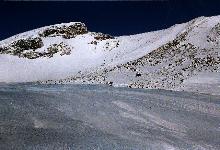 Had I been attempting the trip alone, I would have taken most of my
equipment along in case I got stuck, but with company the weight of safety
equipment could be divided and some left behind, so I was down to under 10kg,
which felt good.
But reorganising and changing Pete's rental skis took time, and it was
10 before we were on our way. Someone told us we could save a few hundred
meters by a short cut higher up the valley than I had skied the
night before, and that we did. Maybe we saved those meters, but we lost 40
minutes and hundreds of calories because we were traversing on ice for several
kilometers. But it was warm and sunny, and we skied in just our undershirts,
still sweating.
By the time we got to Kitteldalen we were already aching from the unpleasant traverse,
but we were still optimistic. On with the climbing skins for a 400m climb over
2km, tough but straightforward, and loose snow that looked like it would be
great fun on the way down. 20m up, snow got under my right climbing skin.
I knew that the glue was old, but it had held perfectly earlier in the trip.
On ice, I now realised, with no loose snow to creep in and wet the glue.
I couldn't believe that I had been so mean as to put off reglueing them until
after this trip. Oh well, I thought, I'll just walk. I took off my skis and
dropped half a meter through the snow. I took a few more steps and had to rest.
Peter realised that we were doomed, and suggested going back, but he didn't
know that I had my stubborness with me. I unpacked it, and tried to walk in
his tracks. Sometimes the packed snow there held, so eventually we came up to
Kittel glacier, but we'd lost another 30 minutes.
And already it was cold -
just 400m up and a slight breeze brought on a heavy fleece and jacket.
We sat on the glacier and drank coffee, wondering where over two hours had
gone. We had barely started. Yet the top was tantalisingly close, in fact it
seemed closer than Vierranvarri that we must go over first, but we knew that the last
stage over Bjoerlings glacier on the direct route needed technical climbing skills.
Had I been attempting the trip alone, I would have taken most of my
equipment along in case I got stuck, but with company the weight of safety
equipment could be divided and some left behind, so I was down to under 10kg,
which felt good.
But reorganising and changing Pete's rental skis took time, and it was
10 before we were on our way. Someone told us we could save a few hundred
meters by a short cut higher up the valley than I had skied the
night before, and that we did. Maybe we saved those meters, but we lost 40
minutes and hundreds of calories because we were traversing on ice for several
kilometers. But it was warm and sunny, and we skied in just our undershirts,
still sweating.
By the time we got to Kitteldalen we were already aching from the unpleasant traverse,
but we were still optimistic. On with the climbing skins for a 400m climb over
2km, tough but straightforward, and loose snow that looked like it would be
great fun on the way down. 20m up, snow got under my right climbing skin.
I knew that the glue was old, but it had held perfectly earlier in the trip.
On ice, I now realised, with no loose snow to creep in and wet the glue.
I couldn't believe that I had been so mean as to put off reglueing them until
after this trip. Oh well, I thought, I'll just walk. I took off my skis and
dropped half a meter through the snow. I took a few more steps and had to rest.
Peter realised that we were doomed, and suggested going back, but he didn't
know that I had my stubborness with me. I unpacked it, and tried to walk in
his tracks. Sometimes the packed snow there held, so eventually we came up to
Kittel glacier, but we'd lost another 30 minutes.
And already it was cold -
just 400m up and a slight breeze brought on a heavy fleece and jacket.
We sat on the glacier and drank coffee, wondering where over two hours had
gone. We had barely started. Yet the top was tantalisingly close, in fact it
seemed closer than Vierranvarri that we must go over first, but we knew that the last
stage over Bjoerlings glacier on the direct route needed technical climbing skills.
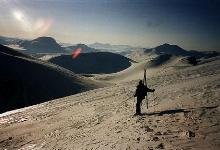 Since it seemed
unlikely that we would make it to the top now, I briefly considered taking that
route as far as I could, but I had asked nothing about the conditions
there from the guides, and so dismissed the idea. Despite our doubts for success,
we decided to push on as far as we could. I tied the ends of my flailing skin
up to the binding, and put loops around the ski and skin at three points along
their length. Less thorough prophylaxis on the left ski finished off my string
supply. The next 200m to the saddle between Vierranvarri and Tolpagorni was too steep and loose
for a direct ascent, and traversing was much tougher on my enfeebled skins.
But we made it again, to be confronted by an ugly 500m long, 30 degree field of jagged
rocks and ice.
Since it seemed
unlikely that we would make it to the top now, I briefly considered taking that
route as far as I could, but I had asked nothing about the conditions
there from the guides, and so dismissed the idea. Despite our doubts for success,
we decided to push on as far as we could. I tied the ends of my flailing skin
up to the binding, and put loops around the ski and skin at three points along
their length. Less thorough prophylaxis on the left ski finished off my string
supply. The next 200m to the saddle between Vierranvarri and Tolpagorni was too steep and loose
for a direct ascent, and traversing was much tougher on my enfeebled skins.
But we made it again, to be confronted by an ugly 500m long, 30 degree field of jagged
rocks and ice.
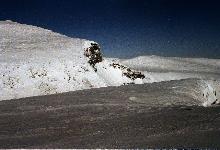 We had to walk, but had heard that our skis might be useful
later, so we strapped them to our packs rather than leave them there.
It was tough going, and would clearly be harder coming down. I was glad I had
company - this was an obvious place to fall and break bones, not something I
would risk alone. Eventually we were up on a wide, smooth, top at 1700m, with an incredible
view down to dozens of other peaks.
This alone would justify the
trip, but of course we still wanted to get to The Big One. We could see it,
just 400m above us, but with a depressingly deep valley between us and it.
And I could tell I was pushing my body beyond its normal limits. Normally I'm
very careful to eat and especially drink regularly when skiing, but trying to
keep up with Peter today I'd neglected my chemistry. My mind was restless, my
body was weak, and my urine was orange. I drank half a litre of water, but I
knew I had lost more than that. I stuffed in handfuls of peanuts and raisins
too, despite the adrenaline I was running on having taken away my appetite.
It was 3pm, and it would be dark by 7. We really didn't want to be on the icy
rocks after dark, but we still thought there might be a chance for the top, so
we allowed ourselves one hour to see how far we could get. At 4 we must be on
our way back. Toppstugan, a cabin 30 minutes from the summit was our intermediate goal.
We traversed down 500m of rock-strewn ice. I kept my skins on to limit my speed,
but it was so steep that only my edges touched the ice, and I accelerated so
fast that when my skins did touch, I lost balance and fell. Each fall saved me
5 minutes of skiing, and eventually I gave up trying to recover from them.
Going up Kebnekaise herself on the other side was technically easier, but I
was starting to suffer from my exertions, and when we got to the stuga I had
an uneasy feeling that things were not right, but I couldn't think clearly
enough to work out what. I had no interest in the view, or photographing the
cabin, but just stuffed down my frozen sandwiches and drank another bottle of
water, which was also beginning to freeze despite being buried deep in my pack.
We had to walk, but had heard that our skis might be useful
later, so we strapped them to our packs rather than leave them there.
It was tough going, and would clearly be harder coming down. I was glad I had
company - this was an obvious place to fall and break bones, not something I
would risk alone. Eventually we were up on a wide, smooth, top at 1700m, with an incredible
view down to dozens of other peaks.
This alone would justify the
trip, but of course we still wanted to get to The Big One. We could see it,
just 400m above us, but with a depressingly deep valley between us and it.
And I could tell I was pushing my body beyond its normal limits. Normally I'm
very careful to eat and especially drink regularly when skiing, but trying to
keep up with Peter today I'd neglected my chemistry. My mind was restless, my
body was weak, and my urine was orange. I drank half a litre of water, but I
knew I had lost more than that. I stuffed in handfuls of peanuts and raisins
too, despite the adrenaline I was running on having taken away my appetite.
It was 3pm, and it would be dark by 7. We really didn't want to be on the icy
rocks after dark, but we still thought there might be a chance for the top, so
we allowed ourselves one hour to see how far we could get. At 4 we must be on
our way back. Toppstugan, a cabin 30 minutes from the summit was our intermediate goal.
We traversed down 500m of rock-strewn ice. I kept my skins on to limit my speed,
but it was so steep that only my edges touched the ice, and I accelerated so
fast that when my skins did touch, I lost balance and fell. Each fall saved me
5 minutes of skiing, and eventually I gave up trying to recover from them.
Going up Kebnekaise herself on the other side was technically easier, but I
was starting to suffer from my exertions, and when we got to the stuga I had
an uneasy feeling that things were not right, but I couldn't think clearly
enough to work out what. I had no interest in the view, or photographing the
cabin, but just stuffed down my frozen sandwiches and drank another bottle of
water, which was also beginning to freeze despite being buried deep in my pack.
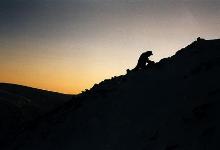 It was now -20C with a slight breeze. I saved my hot water for possible
emergencies later. Rest, food and drink brought my mind back to a state where
I could understand what a bad state I was in. I would never have let myself
get like this if I'd been alone.
The cabin was of little comfort on a day like this when the sun could warm our
bodies, but had made little difference to the temperature inside, where frozen
blankets and a small stove with a minimal amount of emergency wood dispelled any
thoughts of overnighting. We would have survived there, but it wouldn't have been pleasant.
Now I felt better. It was 3:45, and we couldn't quite see the summit.
Just 10 minutes more and we might see it. Peter was sceptical, but agreed to
try. We walked up 100m. Just 5 minutes more and we might see the top. Now I
was sceptical, and it was Peter's turn to be determined. Until he saw the
white fleck on my nose, frostnip, time to give up. I hurried back to the cabin
with my bare hand on the spot, and it disappeared. We hurried down to the
valley and up the other side. Now there was only the
rocky ice field left
between us and the easy snow, so we relaxed briefly and took photographs.
But the rocks were terrible - going down was indeed much worse than coming up.
It was harder to look down for footholds, the ends of my skis kept hitting the
ground and unbalancing me, and I was tired. Both of us developed several more
frostnips until we fashioned protective coverings for our faces.
It was now -20C with a slight breeze. I saved my hot water for possible
emergencies later. Rest, food and drink brought my mind back to a state where
I could understand what a bad state I was in. I would never have let myself
get like this if I'd been alone.
The cabin was of little comfort on a day like this when the sun could warm our
bodies, but had made little difference to the temperature inside, where frozen
blankets and a small stove with a minimal amount of emergency wood dispelled any
thoughts of overnighting. We would have survived there, but it wouldn't have been pleasant.
Now I felt better. It was 3:45, and we couldn't quite see the summit.
Just 10 minutes more and we might see it. Peter was sceptical, but agreed to
try. We walked up 100m. Just 5 minutes more and we might see the top. Now I
was sceptical, and it was Peter's turn to be determined. Until he saw the
white fleck on my nose, frostnip, time to give up. I hurried back to the cabin
with my bare hand on the spot, and it disappeared. We hurried down to the
valley and up the other side. Now there was only the
rocky ice field left
between us and the easy snow, so we relaxed briefly and took photographs.
But the rocks were terrible - going down was indeed much worse than coming up.
It was harder to look down for footholds, the ends of my skis kept hitting the
ground and unbalancing me, and I was tired. Both of us developed several more
frostnips until we fashioned protective coverings for our faces.
 After that, what should have been perfect telemark conditions were wasted on
my exhausted body, and I ploughed and fell my way down to
Kitteldalen. We got back to
the fjaellstation at 7:30. I felt disappointed not just by turning back so
close to the summit, but also by having let myself push too hard to keep up
with Peter's pace. I tried not to think of the maybes - maybe if we hadn't
taken that first short cut, maybe if I'd reglued my skins, then maybe, maybe, we would
have made it. Or maybe not. But next time it would be the Singi route, alone.
After that, what should have been perfect telemark conditions were wasted on
my exhausted body, and I ploughed and fell my way down to
Kitteldalen. We got back to
the fjaellstation at 7:30. I felt disappointed not just by turning back so
close to the summit, but also by having let myself push too hard to keep up
with Peter's pace. I tried not to think of the maybes - maybe if we hadn't
taken that first short cut, maybe if I'd reglued my skins, then maybe, maybe, we would
have made it. Or maybe not. But next time it would be the Singi route, alone.
After two weeks of frustration it was now time to do some real ski touring -
four easy days down to Vakkotavare, with lots of spare time to learn to
telemark properly. But I had forgotten that the weathermen hate me, until they faxed a
forecast for half-storm from the third day. I would have to skip at least one
cabin to avoid getting stuck once more.
The next day it was perfect weather, but I had no energy left and when I started the
long slight incline up through Ladtjovagge in the cold shadow of Skarttatjåkka, I had trouble
enjoying the magnificance of my surroundings, and I hated the pressure of
having to push on. Half way through the valley there was a welcome 100m patch
of sunlight, and the couple in front of me stopped immediately to rest and eat.
I thought I would be smarter, and ski to the end of the patch so that I would
be warm by the time I stopped, and I wouldn't get sweaty when I set off again.
By the time I had taken off my skis and jacket I was in shadow again.
I quickly dragged the sled a few meters down the hill into the sun, and hunted for coffee.
The sun was quicker and I was in shadow again, so I dragged further.
By the time I was finished I had strewn equipment all
the way down to the wise couple. I vowed never to try to be smart again, and
to take a course in astronomy.
I decided to skip Singhi, since that would take the pressure off for the
next day, and I could take a short cut around Unna Jierttas to save a few kilometers.
Up on Jierttajavri was one of the most pleasing views I have ever seen, but all I could
think about was how could I ski another 4 hours, and whether I was really
where I thought I was, since the short cut was unmarked and tracks led in all
directions except for the one that I thought led to Kaitumjaure .
Determined not to repeat the mistakes of the previous day, I replaced all the
water I'd drunk by melting snow on my spirit stove, a painfully tedious
process. 12km behind, 12 to go. Deep breath.
The descent into Tjaektjajåkka was comfortable, the snow was soft and deep, and I could
choose a traverse that was just steep enough to glide down but took me as far
as possible along the valley. After that, time stood still. Every time I thought I
had earned a rest, my watch told me otherwise. The sun started to go down, I
was cold and exhausted, the skiing was monotonous, and progress was
excrutiating. I longed for a quiet empty cabin in which to collapse, but I had to
settle for one with 15 lively French skiers in. Nice people, but 15 too many
for me that day. Normally I chop logs as soon as I arrive, before I have a
chance to relax and get comfortable, but this time it would have to wait.
I slept like a log, and felt surprisingly good. The morning was fine, but
there was an ominous black band on the horizon, slowly but relentlessly
getting thicker. No time to waste. Kaitumjaure is just below tree line, and
it was a steady climb up to Muorki where I could see the Frenchmen, who were
on a detour to telemark in the perfect conditions on Vattitjåkka . I longed to join
them, but knew that an hour could easily make the difference between getting
to the road and spending days trapped at Teusajaure . I pushed on, painfully aware of
wasting conditions that I would probably never meet again - well-trained
muscles, 20cm of fresh, loose snow, 1km of constant 20 degree slope, -10C, sun,
no wind. I could develop my technique more in an hour here than in days of
normal conditions. But I just trudged on. The final descent into Teusa is steep
and wooded, and I had to walk down, with my sled attached in front of me.
It was 12 o'clock - 2.5 hours for 9 kilometers. Not bad.
I asked the warden's advice on continuing, and she was encouraging, provided
that I was willing to turn back if the weather got worse. No problem there.
I squandered an hour on lunch in the stuga, slightly discomforted by the young
scooter driver who worried aloud about travelling to Kaitumjaure in this
weather. Hmm. After the lake I put on my climbing skins, but it was so steep
and deep that I still slipped, and the trees were tightly packed so my skis
and sled kept catching on them. For the first time I started swearing at my
equipment, and growling when I needed to give 105% to get over a particularly
steep stretch. It looked like about an hour to the top, but the warden had
warned me that it was more like 3 hours. It certainly was, and the storm took
about the same time to arrive. At first the wind was behind, and quite
bearable, but then it inexorably became a head wind of at least 15 m/s.
I was already having trouble navigating as this section of Kungsleden is not
winter marked, and the gentle peaks were hard to identify and take bearings on.
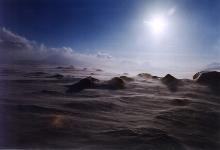 Not that I was going to get completely lost, but I could easily add
several kilometers to an already long trip. With the snow whipped up by the
wind, it became even harder. Luckily it wasn't cold, so even though I
couldn't ski against some of the gusts, I was comfortable and felt safe
continuing. I was heading 90 degrees to a road, so I could afford to miss the
hut. Curiously, it was also sunny, possibly because
I was above the storm.
I had to capture these dramatic conditions on film, but it wasn't easy.
Partly because they were dynamic, but also because my hands froze in seconds
when I took my mittens off, even though I had my normal fleece gloves
underneath. It was -5C, but with windchill it was probably -30.
The one thing that worried me was that the snow was only a few centimeters
deep on the exposed tops, and so I couldn't dig myself down if things got
worse. I had to trust that I could go downwind into a valley if I needed to.
Not that I was going to get completely lost, but I could easily add
several kilometers to an already long trip. With the snow whipped up by the
wind, it became even harder. Luckily it wasn't cold, so even though I
couldn't ski against some of the gusts, I was comfortable and felt safe
continuing. I was heading 90 degrees to a road, so I could afford to miss the
hut. Curiously, it was also sunny, possibly because
I was above the storm.
I had to capture these dramatic conditions on film, but it wasn't easy.
Partly because they were dynamic, but also because my hands froze in seconds
when I took my mittens off, even though I had my normal fleece gloves
underneath. It was -5C, but with windchill it was probably -30.
The one thing that worried me was that the snow was only a few centimeters
deep on the exposed tops, and so I couldn't dig myself down if things got
worse. I had to trust that I could go downwind into a valley if I needed to.
The descent to Vakkotavare is worse than to Teusa, but the snow there was much
deeper and hard to walk in, so I tried to telemark down. Those trees I didn't
hit, my sled did. Snow got in every corner of my clothes, and I didn't make
the most elegant arrival at the cabin, dragging my sled backwards and juggling
my skis and poles under my arms. It was 6pm and no-one was there. The water
buckets were frozen, and the cabin was only 10m from the road. Not comfortable,
not romantically remote, and I knew that once I relaxed it would be a long
time before I would want to ski again. I decided to hitch a ride 15km to Kebnats
and ski across the lake to Saltoluokta, where I could indulge myself in a
sauna, hot food, and the company of Lotta the waitress, before taking the
train home the next day. But this plan presupposed that cars travel that road.
They don't, not that evening at least. I gave up when it got dark at 7, and
started trying to make the cabin homely, hunting around for things with a
torch between my teeth. Later, as I lay in bed, I worked out what the cables on
the ceiling leading to switch boxes and lamps were for. I'd been away from
civilisation too long.
During the night a full storm broke loose, making even driving difficult. I
was offered a lift by some fishermen on their way to Gällivare, and ended up
pushing their car up the worst hill. I was glad I wasn't still in Teusa, and as
we came to Kebnats I decided that I had had enough, and carried on to the
railway station. I was finished. Or was I ?
I was home about a week before restlessness set in, alongside the residual
dissatisfaction with the way all my previous tour plans of the year had been
badly rearranged by the weather. Maybe I should have another go. And there was
just one section of Lappland's Kungsleden left for me to explore -
Abisko to Kebnekaise. Probably doable in a week, 10 days should be comfortable.
I arrived in Abisko late afternoon and did some terribly unimpressive
telemarking on Nuolja, but at least it reminded my muscles and
joints what was in store for them. I have to say that I didn't fall in love
with the place. Not that there is anything wrong with the fjaellstation,
but it lacks something, sitting there on the road, with new, characterless
accomodation blocks. I guess I'd just been spoiled by Saltoluokta and
Kebnekaise. Don't let me stop you going there, lots of people love it,
but I wasn't sad to leave it as I clumped across the road and into the
sparse birch wood on the otherside with its view up to the famous Lapporten
between Tjuonatjåkka and Nissuntjårro .
Two weeks had made an enormous difference to temperatures and day lengths -
now it was +4C and light until 9pm, which took a lot of pressure off each
day's journey, but I would have preferred it to have been 10 degrees cooler
for comfort and ease of waxing. After about 1km I came to flat ground, and I
started to struggle. Could I have become unfit so quickly ? Was there
something wrong with the sled ? Was I getting sick ? Why did it seem such hard
work to keep moving ? Maybe I just needed coffee, but I'm very stubborn about
putting one hour of skiing behind me before stopping for coffee, so I
struggled on, the sled stopping completely each time I lifted a ski.
Coffee made no difference, and eventually I stopped to examine the sled,
finding that the backpack cover that I'd tied over it was hanging down too far
and acting like a snow plough, filling itself up with snow and causing immense
drag. Progress suddenly doubled, and I could enjoy the brilliant sunshine and
easy terrain. Only the last 4km over Abiskojaure dragged a little, but then I
arrived at the cabin at 3pm - 6 hours of daylight left, what would I do with
it all ? Knowing that bad weather was on its way, I considered heading on to
Alesjaure, but that would amount to 34km in one day, far more than I had ever
done before. Instead, I chopped logs and sunbathed until an exceptionally nice
couple from Germany appeared, and we chatted about titanium thermos flasks and
other delights that are lost on some unfortunate people.
One of the things I like best about Sweden is that almost no-one lives here,
but those few exceptions all seemed to be in Abiskojaure that night. Most of
the Swedish army (20 persons) were staying there on exercises, which included
digging a snow cave and then sleeping in the cabin. Wimps. Then there were 10
sports students, and the skier-from-hell, who whined continuously about
everybody else's behaviour whilst being the only one who was not behaving well.
She is the only unsympathetic person I have ever met skiing in the mountains,
and later in the trip I heard several tales from people who had encountered her
elsewhere. I shared a room with her and Kurt and Carola, the Germans,
and she insisted on having a roaring fire with the windows shut. The heat,
along with the snores and odour from her person were too much for me, and
drove me out to sleep on the floor of the day room. Not a good preparation for
20km skiing above tree line, in 15 m/s snowstorm. The weather forecast had
been almost right, except for the little matter of the tail wind becoming a
head wind. I should really have stayed put, but the wardens gave me their
blessing, there was a wind shelter half way, and it would be easy to turn back
downhill with the wind. Given the company I would have in the stuga, I decided
to give it a go. Kurt and Carola would also try, but I went ahead on the
assumption that they would ski faster than I do. It was again +4C, so the snow
was wet and sticky.
Sometimes I think that sleep deprivation helps at times like this,
as my mind is numbed to the unpleasantness of it all. I trudged along against
the snow-saturated wind for 2 hours, delaying my normal coffee break in the
hope of finding some shelter for it. Some hope. I simply climbed higher and
became more exposed, not a rock or a tree to be seen. So I stopped anyway,
having covered 6km and climbed 300m. I was quite comfortable, and confident
that I would at least reach the windshelter at 12km, though I wondered how fit
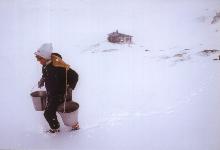 I would feel after a night in a snow hole behind it, not knowing at the time
that the shelter is actually a very nice, if small, stuga. Reaching Alesjaure
was far less certain. Some scooters came
by, and I proudly resisted thumbing a lift. Then one got stuck in a drift, and
as I helped him out he told me that he didn't think they would make it to
Alesjaure.
My confidence dropped under some crucial threshold, and when he offered me
a lift, some primitive part of my brain containing survival instincts took
control, and I accepted. We lunched at the windshelter, which was so well
built that if I'd known I would not have accepted the lift, confident that I
could overnight there.
The guys were on holiday from the south, were very nice,
and told stories of this awful woman they'd met in Unna Allakass. I got far colder on
the scooters than if I'd been skiing, and as soon as we arrived I dived into
my sleeping bag to doze for an hour. Alesjaure is huge, with 4 stugor, 34
beds, a shop and a sauna. I ate dinner with a couple with big dogs that could
pull them 50km in a day, and then we went to the wonderful wood and
snow-powered sauna, running out to roll in the snow when we got
too hot, to the delight of the girls feeding the pack of 20 dogs outside.
I would feel after a night in a snow hole behind it, not knowing at the time
that the shelter is actually a very nice, if small, stuga. Reaching Alesjaure
was far less certain. Some scooters came
by, and I proudly resisted thumbing a lift. Then one got stuck in a drift, and
as I helped him out he told me that he didn't think they would make it to
Alesjaure.
My confidence dropped under some crucial threshold, and when he offered me
a lift, some primitive part of my brain containing survival instincts took
control, and I accepted. We lunched at the windshelter, which was so well
built that if I'd known I would not have accepted the lift, confident that I
could overnight there.
The guys were on holiday from the south, were very nice,
and told stories of this awful woman they'd met in Unna Allakass. I got far colder on
the scooters than if I'd been skiing, and as soon as we arrived I dived into
my sleeping bag to doze for an hour. Alesjaure is huge, with 4 stugor, 34
beds, a shop and a sauna. I ate dinner with a couple with big dogs that could
pull them 50km in a day, and then we went to the wonderful wood and
snow-powered sauna, running out to roll in the snow when we got
too hot, to the delight of the girls feeding the pack of 20 dogs outside.
I wasn't at all bothered to wake to -6C and 20 m/s as this was a good place
to take a rest day - lots of people, lots of food, and a great sauna. I read,
wrote, talked, chopped wood, fetched water from a hole dug down to the stream,
and skied briefly, just to understand why people don't ski in these conditions.
It was fascinating - I wasn't surprised that I couldn't see the markers in
front or behind, despite being only 40m apart, but I was surprised to not be
able to see the ground, nor indeed to know if the ground were flat or not,
nor to be able to judge whether or not I was moving. At one point I thought I was
standing still, but then I inexplicably fell over, and as I hit the ground it
was rushing past me. I was obviously gliding down a hill at some speed,
but with no fixed reference I was unaware of it.
It was a Thursday, and the sauna was full of people who were expected at
work on Monday, trying to decide if they should stick to their plans to get to
Nikkaluokta, or play safe and head back to Abisko. It was nice not to have
those constraints. We woke to a forecast for 20 m/s from the south, and
everyone decided to turn back. I resigned myself to another day there, all
alone, until I remembered that Niklas hadn't been too bothered about being
late back to his job, and so I hunted him out and needed about 3 seconds to
persuade him to take on the storm, which I didn't feel confident to do alone,
though intellectually I knew that this was not the sort of danger that is
reduced by having company. In fact it was an easy trip, 13km to Tjaektja in 5
hours, and no more than 10 m/s wind. It's quite flat despite the mountains all around,
and probably beautiful in better weather.
The stugvaerd was lovely, and quite unlike the others with
her smart clothes, immaculately-groomed hair, and feisty attitude. Very
refreshing. We chopped wood, and I took an evening tour, trying vainly to
telemark again.
The next day was -10C, still and sunny. Niklas took the direct route over the Tjaektja pass,
and I headed off to Nallo, soon to be joined by low cloud, gentle snow,
and light so flat that all features in the ground disappeared. There was a small
ravine to be crossed, which I approached cautiously sideways. I found the edge with my pole,
and leaned down to see how steep it was, losing my balance and breaking through
the cornice I was standing on in the process.
I fell about 3m, miraculously landing flat on my skis and regaining my balance.
My first thought was "wow, that was lucky", closely followed by
"but didn't I have a sled ?", even more closely followed by "Aggghhggg"
as my sled arrived and dragged me another 2 or 3 meters down the ravine.
I suppose this was the nearest I have ever been to a serious skiing accident,
and I thought carefully about what would have happened if I'd broken something
useful, like a leg. I like to think that creeping into my sleeping bag and
windsack, and firing distress rockets when the weather cleared would have saved me.
I like to think things like that.
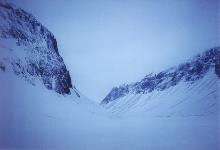
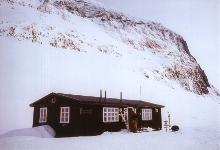 Proceeding along Sielmmavagge was straightforward,
but crossing the subsequent basin was not.
In good visibility it must be pure joy, a wide, well-covered basin where one
can choose exactly the slope one desires. In thick fog it was a nightmare,
being unable to judge slope or speed, and ideally travelling the direct line
to the cabin, as my compass was the only thing that was going to get me into
the right valley and miss the treacherous ravine that preceeds the cabin.
Luckily visibility improved a little just before the ravine, and I could enjoy
the long, gentle traverse to the cabin.
Proceeding along Sielmmavagge was straightforward,
but crossing the subsequent basin was not.
In good visibility it must be pure joy, a wide, well-covered basin where one
can choose exactly the slope one desires. In thick fog it was a nightmare,
being unable to judge slope or speed, and ideally travelling the direct line
to the cabin, as my compass was the only thing that was going to get me into
the right valley and miss the treacherous ravine that preceeds the cabin.
Luckily visibility improved a little just before the ravine, and I could enjoy
the long, gentle traverse to the cabin.
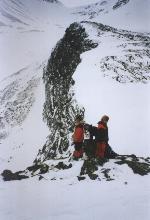 I was joined later by some very nice geographers from Kiruna, and a group
who thanked me for leaving tracks that they could follow through the fog,
though they were surprised by the route that I chose across the first ravine,
considering I had a sled. Just a question of experience, I assured them ambiguously.
I was joined later by some very nice geographers from Kiruna, and a group
who thanked me for leaving tracks that they could follow through the fog,
though they were surprised by the route that I chose across the first ravine,
considering I had a sled. Just a question of experience, I assured them ambiguously.
By midnight the sky was clear again, and I got my first glimse of
the legendary view from Nallo.
The next day the geographers suggested that I take a detour with them to Unna Raita,
on my way to Saelka. The weather was fine as we left Nallo,
and it was great to dump my sled and ski unfettered.
Unna Raita is an unmanned cabin perched
by an impressive 200m precipice which leads to
Vistasvagge and thence to Vistas or Nikkaluokta.
It was certainly worth the 10km
detour to see it. We lunched in the tiny stuga and contemplated the entry in the
guest book that read : "Waited here for storm to pass, 5 days with 7 dogs",
and we hoped
that the dogs were outside. We parted when I found my sled again, and I had a pleasant,
gentle slope 5km down to Saelka where I spent an uneventful night with another large
group of Frenchmen.
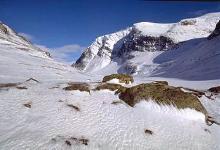
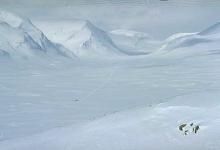 It was +5C, cloudy, grey and miserable for my trip to Singi,
and my enthusiasm for another day of skiing waned, so I headed straight for Kebnekaise,
saving a few kilometers by cutting the corner off Singitjåkka . As I reached the top there, the skies
cleared and I could see 10km back to Saelka,
and the beginning of Lattjovagge,
into which there is a nice kilometer-long slope. I uncoupled my sled, pushed it down
the hill and chased after it, suddenly enjoying skiing again. The sun followed me down
the gentle, 10km-long valley, which was a sheer joy to behold in the warm evening light.
It was +5C, cloudy, grey and miserable for my trip to Singi,
and my enthusiasm for another day of skiing waned, so I headed straight for Kebnekaise,
saving a few kilometers by cutting the corner off Singitjåkka . As I reached the top there, the skies
cleared and I could see 10km back to Saelka,
and the beginning of Lattjovagge,
into which there is a nice kilometer-long slope. I uncoupled my sled, pushed it down
the hill and chased after it, suddenly enjoying skiing again. The sun followed me down
the gentle, 10km-long valley, which was a sheer joy to behold in the warm evening light.
A glass of wine with dinner and a long sauna stole the last of my consciousness,
and I slept deeply and happily as 20cm of new snow fell outside.
Then I could either spend my morning skiing in heavy snow through increasingly dull
forest to Nikkaluokta, or play in the fresh powder around the fjaellstation and later
take a scooter taxi to the bus. I opted for the later, and rounded off my trip with
some great telemarking on the slopes of Darfaltjaerro before lunch.
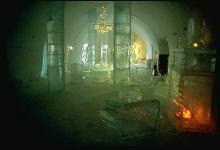
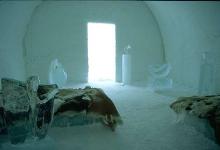 Although the Gods had been cruel to me again on this trip, it was much more satisfying to
have at least followed my planned route whilst augmenting my experience of bad-weather skiing.
It went down in the annals as a succesful trip, and on the way home I got to spend the night in the legendary Ice Hotel near Kiruna. This is a fantastic place
that you must visit. I was worried that I would be disappointed after all
the hype I'd heard about it, but still I couldn't supress a "Wow" as I entered
the lounge. Apart from the wooden front door, absolutely everything is made of
snow or ice, including the chairs, vodka glasses, and the chandelier.
There are reindeer skins on the beds to stop them melting. Go there.
Although the Gods had been cruel to me again on this trip, it was much more satisfying to
have at least followed my planned route whilst augmenting my experience of bad-weather skiing.
It went down in the annals as a succesful trip, and on the way home I got to spend the night in the legendary Ice Hotel near Kiruna. This is a fantastic place
that you must visit. I was worried that I would be disappointed after all
the hype I'd heard about it, but still I couldn't supress a "Wow" as I entered
the lounge. Apart from the wooden front door, absolutely everything is made of
snow or ice, including the chairs, vodka glasses, and the chandelier.
There are reindeer skins on the beds to stop them melting. Go there.
Update 2017 : Happy ending - I now have breakfast every day with Lotta the waitress from Saltoluokta...
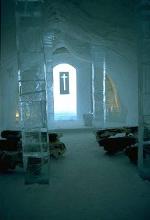
© Mark Harris 1999
(On to Abisko and Norwegian cabins)
(Back to ski report index)
(MRH homepage)

 Pårte is nice, as were the wardens (and every warden I've ever met), but on
the third day of watching snow drifts form and reading "Till Fjaells"
magazines from the '70s, I was getting a little restless.
On top of the blizzards was the problem that the next stage to Aktse is around
30km long in the winter, over a regulated lake with regions of open water.
The snow was deep and untracked, and I was told that knowing when to turn
north over Tjaktjavare is crucial, and tricky in poor visibility. I wanted a
very nice day before attempting this one. It didn't come, but Germans did.
They had a tent, a GPS navigation system, and experience. No problem, whatever
the weather, we would head off together the next day. Meanwhile they kindly
shared with me something brown, tasty, and indigestible. My stomach started cramping an
hour or so later, and only relaxed slightly the following morning. But at
least I will be able to tell my grandchildren about the time I braved a
blizzard at 1, 3 and 5am to get to the outhouse, where the wind was strong
enough to blow snow up through the toilet, and to give a whole new meaning to
the term paper recycling.
Pårte is nice, as were the wardens (and every warden I've ever met), but on
the third day of watching snow drifts form and reading "Till Fjaells"
magazines from the '70s, I was getting a little restless.
On top of the blizzards was the problem that the next stage to Aktse is around
30km long in the winter, over a regulated lake with regions of open water.
The snow was deep and untracked, and I was told that knowing when to turn
north over Tjaktjavare is crucial, and tricky in poor visibility. I wanted a
very nice day before attempting this one. It didn't come, but Germans did.
They had a tent, a GPS navigation system, and experience. No problem, whatever
the weather, we would head off together the next day. Meanwhile they kindly
shared with me something brown, tasty, and indigestible. My stomach started cramping an
hour or so later, and only relaxed slightly the following morning. But at
least I will be able to tell my grandchildren about the time I braved a
blizzard at 1, 3 and 5am to get to the outhouse, where the wind was strong
enough to blow snow up through the toilet, and to give a whole new meaning to
the term paper recycling.
 The next morning was indeed beautiful, but the temptation to head back to
Pårte was moderated by the certainty that I would be trapped there again.
Turning around a second time would be unbearable. Instead I took the bus to
Saltoluokta, thinking that I could at least see some real mountains, do some
day trips, and maybe, maybe, do my planned trip in reverse. After waiting so
long for good weather, to be watching it from bus windows for 6 hours was
agonising, but after a few hours skiing around Saltoluokta, taking a sauna,
and enjoying the beauty of the 80-year-old fjaellstation, I was happy again
and ready to start over. I at least wanted to get to Aktse and Rapadalen, even
if I decided to turn around there. I was waiting to hear about some job
interviews, but I reckoned I was safe for another 4 or 5 days.
The following morning was beautiful again, and I was happy enough to treat myself
to breakfast in the restaurant, with the justification that there is a limit
to how much home-made porridge I can stuff into myself in the morning, but no
limit to how much fresh bread and eggs I can eat, and I needed the nutrition.
My waitress was cute and somehow familiar. Yes, it was Lotta, whom I'd met on
the train up north a year before. We chatted, and it turned out that she
had the following two days off, so I abandoned my plans for Aktse, and
instead arranged that I would go off to Sitojaure, Lotta would follow the
next day, and we would ski back together.
Rapadalen may be the most beautiful place in Sweden, but I bet it can't cook.
The next morning was indeed beautiful, but the temptation to head back to
Pårte was moderated by the certainty that I would be trapped there again.
Turning around a second time would be unbearable. Instead I took the bus to
Saltoluokta, thinking that I could at least see some real mountains, do some
day trips, and maybe, maybe, do my planned trip in reverse. After waiting so
long for good weather, to be watching it from bus windows for 6 hours was
agonising, but after a few hours skiing around Saltoluokta, taking a sauna,
and enjoying the beauty of the 80-year-old fjaellstation, I was happy again
and ready to start over. I at least wanted to get to Aktse and Rapadalen, even
if I decided to turn around there. I was waiting to hear about some job
interviews, but I reckoned I was safe for another 4 or 5 days.
The following morning was beautiful again, and I was happy enough to treat myself
to breakfast in the restaurant, with the justification that there is a limit
to how much home-made porridge I can stuff into myself in the morning, but no
limit to how much fresh bread and eggs I can eat, and I needed the nutrition.
My waitress was cute and somehow familiar. Yes, it was Lotta, whom I'd met on
the train up north a year before. We chatted, and it turned out that she
had the following two days off, so I abandoned my plans for Aktse, and
instead arranged that I would go off to Sitojaure, Lotta would follow the
next day, and we would ski back together.
Rapadalen may be the most beautiful place in Sweden, but I bet it can't cook.

















